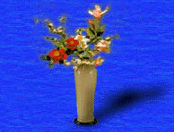
![]()


![]()

The art of Chinese flower arrangement has since Tang Dynasty times been a major current in het classical art of China, enjoying widespread acceptance as one of the "Four Arts" of an educated Chinese gentleman. It was also the basis from which the arts of Japanese and Korean flower arrangements developed.
Today when one speaks of the art of flower arrangement as it has taken shape in the East, however, most people know only of the highly stylized form of Japanese flower arrangement. The Chinese art form has since the 19th century declined so rapidly that few even amongst the Chinese know of its existence.
It is for this reason that the Women's Garden and Art Club of the Republic of China decided in 1983 to try to revive this lost art and give it new meaning in 20th century Chinese life styles.
Founded in 1972 by a group of Chinese ladies with a deep love for their country's cultural heritage, the Women's Garden and Art Club of the Republic of China to date has sponsored projects in Chinese gardening, knotting, frog making, paper cutting, calligraphy, and painting, to name a few. More recently, club members have spent the better part of 1983 collecting, studying and collating materials from over fifteen hundred years for their Chinese Flower Arrangement Exhibition. which opened at the National Museum of History in Taipei, March 24, 1984.
The exhibition included fifty some arrangements, all done in the four classical Chinese styles of flower arrangement - namely temple, court, literati, and folk flower arrangements. Most of them are included in this book commemorating the exhibition.
In addition to the arrangements themselves, we have included the address given by Former President C.K. Yen at the opening ceremony of the exhibition and the welcome address given by our Club President Mrs. Yu Kuo-hwa. Also included are the sections on the history and appreciation of, as well as the vessels used in, Chinese flower arrangements
The arrangements themselves are all reconstructed, with the help of Prof. Huang Yung-chuan of the National Museum of History and countless flower lovers, from paintings and descriptive texts. For instance,. each arrangement in the book is shown together with a painting culled from the cultural archives of the Northern and Southern Dynasties, the Tang Dynasty, the Sung Dynasty, on down to the Ching Dynasty, depicting the evolution of the art of flower arrangement in China over centuries of time. To show what the original arrangement must have been like, club members had the vessels copied ,and, in instances where the types of flowers shown in the paintings were not available in their natural form,. had the flowers fabricated by hand.
Many people have asked why we had gone to so much trouble to painstakingly reconstruct the arrangements. We believe that the first step to the revival of a lost art is to show it in its former glory. Once seen, people will come to understand, appreciate, and study it. The text describing the arrangements are thus descriptions of the arrangements as found in the paintings, and do not necessarily match the reconstructed arrangements, which might have been slightly altered in its making by club members.
We are especially grateful to Chairman Chen Chi-lu and the Council for Cultural Planning and Development for agreeing to publish the book so that flower lovers in Taiwan and around the world would thru this book come to know and love Chinese flower arrangement.
Lastly, but not least, we would like to take this opportunity to thank the National Museum of History for holding the exhibition, to thank Mr. Huang Yung-hung and Ms. Yeh Ting-fen for designing the exhibition, and the countless flower lovers who gave so generously of their time to help make the exhibition possible.
![]()
[preface] [
styles] [religious] [palace]
[literati] [folk]
[9 pricniples] [significance]
[preveration] [vessels]
[appreciatin]
[Pavilion of Taiwan,
R.O.c] [Cultures]
[Council For Cultural
Affairs]